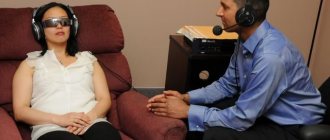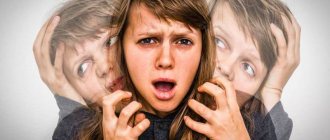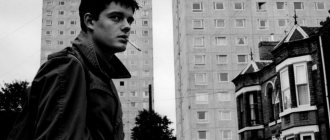Every person has a response to some event. Depending on the degree of reaction and mental state due to a stressful incident, various types of reaction are distinguished, which include reactive psychosis. This condition is pathological, therefore, the causes and symptoms of its development, as well as individual treatment methods, are identified.
All people experience stressful situations of varying severity. Some incidents pass quickly, others leave a mark on a person’s soul in the form of PTSD, depression, mental suffering, etc. Reactive psychosis, like other reactions, can be explained by the emotions that a person experiences as the situation develops. The most important emotion is a person’s negative attitude towards what is happening to him.
Thus, reactive psychosis can be called a consequence of a large accumulation of negative emotions that a person cannot cope with. This leads to a distortion of worldview and consciousness. The psyche strives to hide from the negative influence of the outside world on it, creating various deviations and disorders.
Is it possible to eliminate reactive psychosis by changing your attitude to the situation? The online magazine psytheater.com points out that this disorder no longer allows a person to change, so it is impossible to completely recover simply by simply changing one’s emotions regarding a stressful situation. Often the patient cannot do without the help of psychiatrists.
Clinical picture
According to the characteristics of their occurrence and course, shock (acute), subacute, and prolonged R. are distinguished.
Shock (acute) reactive psychoses
(psychogenic shock) occur under the influence of a sudden strong mental trauma that poses a threat to existence (earthquake, fire, flood, etc.). They manifest themselves in hypokinetic and hyperkinetic forms. The hypokinetic form of R. p. (acute psychogenic stupor) is a sudden state of complete immobility (see below Psychogenic stupor); hyperkinetic form - sudden onset of chaotic, meaningless motor excitation (see Hyperkinesis). Both forms of psychosis are accompanied by twilight stupefaction (see), amnesia (see), autonomic disorders (tachycardia, sudden pallor or redness of the skin, profuse sweat, etc.) and last several minutes or hours.
Subacute reactive psychoses
occur most frequently. These include psychogenic paranoid, hallucinatory-paranoid psychosis, psychogenic depression, syndrome of delusional fantasies, hysterical psychoses, psychogenic stupor. Psychogenic paranoid - R. p. with figurative delusions of persecution (see Delirium), accompanied by fear and anxiety. Occurs in individuals in an unusual situation (relative isolation); Insomnia (see) is of great importance. In the initial stage, patients develop an incomprehensible, painful anxiety. Then comes delirium, which reflects a specific traumatic situation. Patients defend themselves from imaginary pursuers and sometimes become aggressive. This condition lasts for 2 weeks. up to two months. Gradually, delirium disappears, criticism of painful disorders is restored, going through a period of doubt.
Hallucinatory-paranoid psychosis is usually encountered in forensic psychiatric practice. It is determined by a combination of delusions of persecution with verbal hallucinations (see) and individual phenomena of mental automatism (see Kandinsky - Clerambault syndrome). In the initial period, mentalism arises (a non-stop flow of thoughts, against the will). Memories of long-forgotten episodes emerge. Along with this, there appears a feeling of “pulling out”, “reading” thoughts, a feeling of “internal openness”, which is combined with auditory pseudo-hallucinations of psychogenic content (usually a situation of investigation). Patients talk about inner voices that interfere with their thoughts, repeat the investigative process, and sound in their heads. Individual components of senestopathic automatism appear (for example, unpleasant sensations in the body, a feeling of cold, burning). At the height of psychosis, against the background of an intense affect of fear, true verbal hallucinations predominate, the content of which is associated with a traumatic situation. The voices are multiple in nature (poly-vocal hallucinosis) or can take the form of dialogue (voices discuss the patient’s behavior, threaten, predict death). Sometimes individual visual hallucinations appear, also reflecting the situation. In the wedge, a large place is occupied by delusions of relationship, meaning and persecution, delusions of external influence, constant control and influence carried out with the help of hypnosis, special devices. The content of hallucinatory-delusional psychosis is associated with a psychogenically traumatic situation. A change in the picture of the disease occurs immediately after patients are admitted to the hospital. The hallucinations disappear first; a tense affect of fear is replaced by depression; delirium acquires a residual character. Criticism of the painful disorders suffered is restored gradually. Asthenia is observed for a month or more (see Asthenic syndrome).
Psychogenic depression most often occurs in the following wedge variants: simple reactive depression, depressive-hysterical and depressive-paranoid syndromes. Simple reactive depression is manifested by a low-sad mood with motor and ideational retardation. The content of the patients’ ideas reflects a traumatic situation.
Depression in depressive-hysterical syndrome (hysterical depression) is characterized by the extreme expressiveness of all external manifestations. Affective disorders are manifested by a combination of depression, anxiety, anger, tearfulness; they are changeable and depend on the situation. Ideas of self-accusation and even self-reproach are absent. Patients blame others for everything, and at the same time express exaggerated fears about their health, believing that their condition is so serious that it excludes the possibility of making any demands on them. Facial expressions, motor skills and statements of patients are characterized by theatricality, the desire to attract attention and evoke sympathy. In this case, there is no psychomotor retardation. Sometimes melancholy is combined with anger, depression becomes agitated, and patients harm themselves or make demonstrative suicide attempts. The course of hysterical depression is favorable. The disappearance of painful disorders can occur gradually or immediately after a changed situation or treatment. During recovery, partial amnesia is noted, which indicates the presence of a change in consciousness during the period of psychosis, defined as hysterically narrowed. Depressive-hysterical syndrome, as a rule, is combined with such hysterical manifestations as pseudodementia (see Pseudo-dementia syndrome), puerilism (see), delusional fantasies (see syndrome of delusional fantasies below).
Depressive-paranoid syndrome develops gradually. At first, a melancholy mood and motor retardation appear. However, ideational inhibition is absent. Patients have an abundance of thoughts, the content of which is associated with a psychotraumatic situation; consciousness concentrates on dominant experiences, which allows it to be defined as affectively narrowed. The surrounding environment is perceived as unreal, “in shades of gray,” like “through fog” or “thick water.” As depression deepens, a delusional interpretation of the environment is noted (in the words and gestures of others, patients see hints of impending punishment, etc.). At the same time, mental retardation appears. In the future, depressive stupor may develop. The disease usually lasts 2-3 months, patients lose weight, they experience severe autonomic disorders - tachycardia, blood pressure fluctuations, a feeling of pressure, pain and heaviness in the heart. There are often persistent suicide attempts. When the situation changes or with treatment, first of all, the depressive stupor disappears, then the delusional interpretation of the environment, and lastly, the affect is normalized. Simultaneously with the improvement in mood, criticism of the painful condition experienced appears. Asthenia is observed for a month or more.
The syndrome of delusional fantasies (see) is manifested by unstable, changeable ideas, which do not form a definite system and have fantastic content. In some cases, delusional fantasies develop acutely against the background of a hysterically narrowed consciousness. Unstable ideas of greatness and wealth predominate, which in an exaggerated form reflect the desire to escape from an unbearable situation. Thus, patients talk about their flights to the moon, about the untold riches they possess, about great discoveries of national importance. The content of these statements contradicts the main anxious background of the mood, which changes depending on external factors and the doctor’s questions. In other cases, delusional fantasies are more complex and persistent, showing a tendency towards systematization. During the period of reverse development of mental retardation, situationally determined depression comes to the fore, fantastic statements fade, reviving only for a short time when the patients become agitated due to the impact of additional psychotraumatic experiences.
Reactive hysterical psychoses include Ganser syndrome (see Ganser syndrome), pseudodementia syndrome (see), puerilism (see), as well as mental regression syndrome (feral syndrome), which is one of the most rare forms of R. p. and is manifested by hysterical confusion and special psychomotor agitation (patients crawl, growl, lap from a plate, etc.). Sometimes this behavior is accompanied by delusions of reincarnation (patients move on all fours, like dogs, make movements with their hands that resemble the flapping of the wings of birds, etc.).
Psychogenic stupor is characterized by complete immobility and mutism (refusal to speak). According to psychopathol. manifestations can be identified as hysterical, depressive and hallucinatory-paranoid stupor. The most common occurrence is hysterical stupor. Sometimes it occurs acutely, immediately after mental trauma, as an independent form of hysterical stupor. In most cases, hysterical stupor develops gradually, being the last stage in the succession of various hysterical syndromes (hysterical depression, pseudodementia, puerilism). The main feature that defines the wedge, the picture of hysterical stupor, is the affect characteristic of hysterical depression. Despite the immobility and mutism, the facial expressions and pantomime of such patients are expressive; they reflect dominant affect. So, the facial expression can be gloomy, angry; sometimes facial expressions reflect frozen suffering and despair. Against the background of psychomotor retardation, a number of hysterical symptoms characteristic of pseudo-dementia or puerilism are revealed. Consciousness in patients is altered and in its structure is close to affective-narrowed. The physical condition of patients, despite prolonged refusal to eat, is usually relatively good. The disappearance of stuporous disorders can occur suddenly or gradually.
Depressive stupor develops gradually, being the final stage of psychogenic depression, accompanied by psychomotor retardation (see Depressive syndromes). In his wedge, the picture retains the affect of melancholy, which manifests itself in the facial expressions and motor skills of patients (usually they do not get out of bed, and if this happens, they sit motionless in a monotonous position, bent over, with their heads bowed low). Patients do not take care of their appearance, often refuse to eat, as a result they suddenly lose weight, and stop maintaining contact with others. Their facial expression is depressed and suffering, their gaze is motionless, the corners of their mouth are downcast, their lips are trembling. Psychomotor retardation often reaches the level of substupor. Patients have difficulty comprehending the questions asked to them and either do not answer at all or give short, monosyllabic answers after repeating the question many times. They speak slowly, in a quiet, slightly modulated voice, interrupting their speech with long pauses. Their individual statements reflect the presence of ideas of self-blame directly related to a specific situation, as well as suicidal thoughts. The exit from a stuporous state most often occurs through a stage of depression, followed by partial amnesia of surrounding events. Asthenia remains for some time.
Hallucinatory-paranoid stupor develops gradually. His wedge picture reflects previous psychopathological disorders. In patients, an anxious-sad mood is combined with delusional ideas of relationship, special significance, persecution, external influence, which are united by a common content associated with a psychogenic-traumatic situation. The dominant depressive-anxious affect is accompanied by motor retardation, which is manifested in slow, uncertain movements, a monotonous mournful and at the same time anxious facial expression. Some statements from patients reflect the presence of psychogenic-related patol. experiences. They believe that their children and family died, express ideas of guilt, claiming that they disgraced their family with their behavior, and are to blame for the death of loved ones. Ideas of self-blame are accompanied by refusal to eat, resulting in increasing exhaustion and psychomotor retardation (see Paranoid syndrome). When recovering from a stuporous state, patients retain memories of the delusional and hallucinatory experiences they experienced.
Protracted reactive psychoses
Based on the characteristics of the wedge, patterns and patterns of dynamics, they are divided into three groups. Prolonged relapses of the first group are characterized by the same type of non-progressive course. At the same time, throughout the entire disease, a certain, strictly defined psychopathological syndrome persists, most often it is hysterical depression, pseudodementia, pseudo-dementia-puerile syndrome or delusional fantasies.
In the wedge, the picture of protracted psychoses of the second group, there is a gradual change in hysterical syndromes, and there is a tendency to deepen the reactive state. Hysterical depression is replaced by pseudodementia or pseudodementia-puerile syndrome. The deepening of the reactive state is manifested by the development of stupor, in a wedge, the picture of which reflects previous disorders (individual manifestations of depression, pseudodementia, puerilism). Recovery occurs slowly, with a repetition of previous disorders, and individual monosymptoms (paralysis, paresis, mutism, etc.) remain for a long time.
Protracted R. of the third group have a sluggishly progressive type of course, with the psychopathological picture and dynamics, on the one hand, defining the wedge, the signs characteristic of the described groups of reactive psychoses, and on the other, patterns inherent only in this group. In accordance with this, in some cases the wedge, the picture at the initial stage is characterized by hysterical depression and other hysterical manifestations (see Hysteria), most often in the form of individual elements of pseudodementia, in others, depressive-paranoid disorders predominate without the symptoms characteristic of the hysterical syndrome. A common distinguishing feature of this group is the state of psychomotor retardation that occurs in the early stages. In the future, the wedge, the picture is characterized by lethargy, monotony, monotony of the course, without any pronounced fluctuations and changes in syndromes, with a steady progressive deepening of psychomotor retardation, at the same time, progressive physical exhaustion occurs with trophic disorders and pronounced vegetative-metabolic changes, indicating suppression adaptive-trophic functions of the body. In this case, there is a gradual fading and modification of the initial psychogenically caused symptoms. Anxiety and melancholy become monotonous, without showing any fluctuations depending on the psychogenic-traumatic situation. The course of protracted psychoses in this group does not show a direct dependence on the cause of the disease. Recovery in all its manifestations is, as it were, partial in nature. With the gradual restoration of individual mental functions over a long period of time, it remains incomplete. Prolonged R. p. lasts 6 months or more.
Reactive psychosis: main symptoms
Reactive psychosis does not occur on its own. It is a response to a situation that threatens a person’s life or well-being. This could be an accident, natural disaster, bankruptcy, loss of loved ones, or a trial.
The first signs of this condition appear immediately after a psychological incident; they can last from several hours to several months. Depending on the symptoms, the doctor makes a diagnosis and selects the most effective treatment.
The main symptoms of reactive psychosis:
- impaired perception of what is happening around;
- inappropriate behavior;
- psychosis develops along with acute stress;
- a person may fall into a stupor or, on the contrary, move chaotically;
- autonomic disorders as an additional symptom (blood pressure surges, tachycardia);
- partial memory loss.
The symptoms of this disease greatly depend on how the traumatic situation is resolved. If the circumstances continue, it causes a protracted condition. If the cause of stress can be eliminated very quickly, then the symptoms disappear after it.
Experts use characteristic symptoms to distinguish reactive psychosis from schizophrenia or manic-depressive psychosis, drug intoxication.
Etiology and pathogenesis
In the occurrence of mental retardation, the combination of the nature of mental trauma and the constitutional characteristics of the individual is of decisive importance. Predisposing factors include changes caused by previous traumatic brain injuries, hron. infections, intoxications, atherosclerosis, as well as periods of age-related crises. Despite the variety of psychotraumatic factors, the psychogenic disorders they cause are largely determined by the value system of a given individual. The impact of psychotraumatic factors can be acute and delayed. The duration of the psychogenic-traumatic situation matters, but to a greater extent - the characteristics of the individual’s attitude to this situation (adaptation or sensitization).
Treatment of reactive psychosis
Although this disease is very serious, with timely treatment it has a favorable prognosis. It requires hospitalization, but the first step should be to eliminate the psychogenic situation that provoked reactive psychosis. The patient must be admitted to a psychiatric ward. Treatment depends on the characteristics of the person and the severity of his condition.
It is selected individually:
- In case of overexcitation, a course of tranquilizers and neuroleptics is prescribed.
- To eliminate reactive depression, there is a whole list of antidepressants.
- Delusional ideas are eliminated with the help of antipsychotics.
After the patient is removed from the state of reactive psychosis, he undergoes a course of psychotherapy in order to develop the protective mechanisms necessary to maintain adequacy. A person also needs to work through all the feelings that he has experienced in connection with this condition and the current situation. A person should not be overly fixated on what happened. The patient is first brought out of the acute state, since only in this case does he begin to adequately perceive those around him, including the doctor’s recommendations and arguments. A psychotraumatic situation is something from which no one is immune, because anything happens in life. Sometimes a person cannot cope with it on his own. Then, specialists with experience and modern pharmaceuticals need to be involved in the treatment of reactive psychosis.
Diagnosis
The diagnosis is made on the basis of a characteristic wedge, picture, features of the development of the disease in a psychogenic-traumatic situation and the course associated with the influence of psychogenic trauma.
Differential diagnosis
R. p. is most difficult with schizophrenia (see). It is carried out on the basis of a comparative comparison of the wedge, the picture and on identifying the atypicality of the picture of the prevailing disorders and the patterns of their development, characteristic of various variants of R. p. So, with R. p., in the wedge, the leading picture is hallucinatory- paranoid or depressive-paranoid disorders, atypicality is found in the features of the syndrome of mental automatism. Characteristic features of the psychogenic variant of mental automatism syndrome are a limited number of its manifestations (phenomena of an influx of thoughts, auditory pseudohallucinations, unusual sensations), their other quality (the predominance of elements of violence, impaired activity in the absence of phenomena of alienation of one’s own thoughts, feelings and actions) and content (it is connected with a traumatic situation).
Prognosis and Prevention
The prognosis is usually favorable. With prolonged R. p. it is different; Thus, with a sluggishly progressive type of course, the prognosis is unfavorable.
Prevention consists of carrying out psychohygienic measures (see Psychohygiene) and early treatment of psychopathol. disorders that arise following the effects of mental trauma.
Bibliography:
Avanesova T. S., Ivanov N. A. and Kokanbaeva R. F. Activity of blood monoamine oxidase in reactive states and schizophrenia, in the book: New data on the pathogenesis, clinic and treatment of nervous and mental disorders. ill., ed. G.V. Morozova et al., p. 3, Chisinau, 1977; Buneev A. N. About schizophrenic reactions, in the book: Probl. court. psychiat., ed. Ts. M. Feinberg, p. 45, M., 1938; aka, The problem of reactive states in the forensic psychiatric clinic, ibid., Sat. 6, p. 105, M., 1947; Vvedensky I. N. To the doctrine of Ganser’s symptom, Sovrem. psychiat., May, p. 110, 1907; aka, Forensic psychiatric assessment of reactive states, in the book: Probl. court. psychiat., ed. Ts. M. Feinberg, p. 5, M., 1938; Gannushkin P. B. Clinic of psychopathy, their statics, dynamics, systematics, M., 1933; Gilyarovsky V. A. Old and new problems of psychiatry, M., 1946; Zhislin S.G. About acute paranoids, M., 1940; Krasnushkin E.K. On the issue of classification of psychogenies, Proceedings of Psychiat. clinics of the 1st Moscow State University, v. 3, p. 362, M., 1928; Morozov V. M. and Nadzharov R. A. About hysterical symptoms and phenomena of obsession in schizophrenia, Zhurn. neuropath, and psychiat., t. 56, no. 12, p. 937, 1956; Morozov G.V. Stuporous states, M., 1968; aka, Psychogeny and schizophrenia, in the book: Vopr. psychoneurol., ed. A. A. Abaskulieva, V. 7, p. 92, Baku, 1977; Selye G. Essays on the adaptation syndrome, trans. from English, M., 1960; Felinskaya N. I. Reactive states in the forensic psychiatric clinic, M., 1968; aka, Modern doctrine of reactive states and key issues of this problem, Zhurn. neuropath, and psychiat., t. 80, no. 11, p. 1717, 1980; Khokhlov L.K. Degrees of pathognomonicity of the syndrome of mental automatism of the clinical picture of schizophrenia, in the book: Actual. problem neuropath and psychiatrist, ed. L. L. Rokhlina, p. 236, Kuibyshev, 1957; A st-rup S., Fossum A. a. H o 1 t-b o e R. A follow-up study of 270 patients with acute affective psychoses, Copenhagen, 1959, bibliogr.; In irn-b aum K. Psychosen mit Wahnbildung und wahnhafte Einbildungen bei Degenera-tiven, Halle, 1908; Jaspers K. Allgemeine Psychopathologie, B., 1973; Lab-hard t F. Die schizophrenieahnlichen Emotionspsychosen, B. ua, 1963; Lang-f e 1 dt G. Schizophrenic und schizophre-nieforme Zustande, Arch. Psychiat., Bd 196, S. 574, 1958; Schneider K. Die abnormen seelischen Reaktionen, Lpz.—Wien, 1927.
K. L. Immerman.









